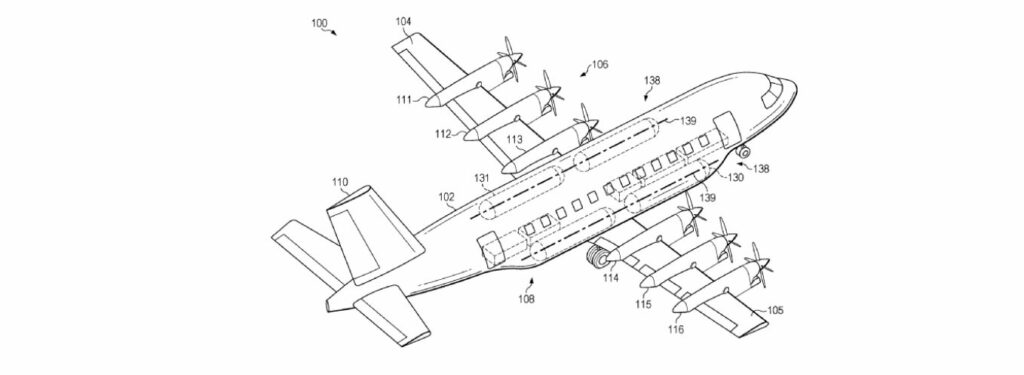While the promise of zero-emission flight is tantalizing, the practical challenges of integrating hydrogen into passenger aircraft are substantial. Boeing’s patent application reveals innovative solutions to some of the most pressing hurdles, particularly those related to the use of liquid hydrogen (LH2).
The application, which details a configuration for a LH2 fuel cell aircraft with distributed systems, tackles the core issue: how do you safely and efficiently store and utilize cryogenic liquid hydrogen on a passenger plane? The proposed design focuses on a 50-passenger aircraft, a crucial segment for regional air travel.
The LH2 Packaging Problem: Tanks Above the Wings?
One of the most striking aspects of the design is the proposed location of the liquid hydrogen tanks. Instead of squeezing them within the fuselage (which presents significant safety and space constraints), the tanks are positioned outside the fuselage, extending above the wings and running alongside the fuselage itself, just below the windows. This might seem counterintuitive, but the application argues that this configuration minimizes added weight and surface area while ensuring safer integration of the tanks.
Distributed Propulsion: Redundancy and Efficiency
Beyond tank placement, the application details a distributed propulsion system. Instead of relying on two or four large engines, the design utilizes six engine nacelles. This approach offers several advantages:
- Redundancy: More engines mean greater safety in case of a failure.
- System Distribution: Distributing the fuel cell stack and thermal management systems across multiple nacelles eases the challenge of packaging these bulky components. Smaller systems in each nacelle translate to lower electric motor power requirements overall.
High-Temperature PEM Fuel Cells: A Key Enabler?
The application also hints at the potential use of high-temperature proton exchange membrane (PEM) fuel cells. These next-gen fuel cells offer a critical advantage: smaller heat exchangers. High-temperature PEMs reject heat at a higher temperature, making the cooling process more efficient and reducing the size of the heat exchangers needed. The incorporation of microchannel flow passages in the heat exchanger design could further reduce the size of the heat exchanger.
Venting the Pressure: A Necessary Safety Feature
Safety is paramount. To address the pressure buildup within the liquid hydrogen tanks during flight, the design includes a venting system. Conduits run from the tanks to the top of the vertical tail, allowing for the safe release of excess pressure.
Beyond the Hardware: System-Level Thinking
The patent application is just one piece of a larger puzzle. It is related to several other patent applications filed on the same day, covering crucial aspects such as:
- Advanced cooling systems for aircraft electronics (Pumped Two-Phase Cooling)
- Innovative nacelle heat exchanger integration methods
- Liquid hydrogen feed systems
- Start-up procedures for high-temperature PEM fuel cell aircraft
- Thermal management strategies.
While significant hurdles remain, this patent application offers a glimpse into the innovative thinking driving the development of hydrogen-powered aircraft. The solutions presented – from unconventional tank placement to distributed propulsion and advanced fuel cell technology – represent important steps toward realizing the promise of clean, sustainable aviation. The future of flight may very well be fueled by hydrogen.
Join us as we tackle the hydrogen role in aviation in our Face 2 Face series.





